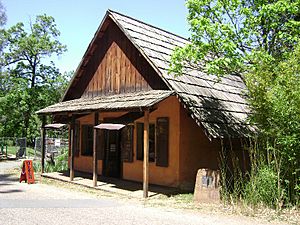Fiddletown, California facts for kids
Quick facts for kids
Fiddletown
|
|
|---|---|

The Chew Kee Chinese Apothecary (historic rammed-earth structure) in Fiddletown
|
|
| Country | |
| State | |
| County | Amador County |
| Settled | 1849 |
| Area | |
| • Total | 4.636 sq mi (12.007 km2) |
| • Land | 4.636 sq mi (12.007 km2) |
| • Water | 0 sq mi (0 km2) 0% |
| Elevation | 1,683 ft (513 m) |
| Population
(2020)
|
|
| • Total | 279 |
| • Density | 60.18/sq mi (23.24/km2) |
| ZIP code |
95629
|
| Area code | 209 |
| FIPS code | 06-23980 |
| GNIS feature IDs | 223482, 2583012 |
|
Fiddletown
|
|
| NRHP reference No. | 78000655 |
| Significant dates | |
| Added to NRHP | June 7, 1978 |
Fiddletown is a small community in Amador County, California. It sits at an elevation of 1,683 feet (513 meters) above sea level. This historic place is recognized as a California Historical Landmark. It is also listed on the National Register of Historic Places.
Fiddletown is a census-designated place, which means it's an area identified by the U.S. Census Bureau for statistical purposes. The community uses ZIP code 95629 and area code 209. In 2020, Fiddletown had a population of 279 people.
Contents
History of Fiddletown
Fiddletown was first settled in 1849 by people from Missouri. In the 1850s, it became an important trading hub. It supported many mining camps in the surrounding area. The town also had one of California's largest Chinese communities. By the 1860s, over 2,000 Chinese residents lived there.
How Fiddletown Got Its Name
When Fiddletown was founded, placer mining was the main way to find gold. This mining method needs a lot of water. The local water source, Dry Creek, would often dry up in the summer. During these dry periods, miners couldn't work. People said they were "fiddling around" because they had nothing to do. This is how the town got its unique name.
The Name Change to Oleta
Later, in 1878, a local resident felt embarrassed by the name "Fiddletown." He successfully pushed to change the town's name to Oleta. He named it after his daughter. This name lasted for many years.
However, after this resident passed away in 1932, the people of the town wanted their original name back. They asked for it to be changed back to Fiddletown. The name Fiddletown is still known for being an unusual place name.
A post office first opened in Fiddletown in 1853. Did you know there's also a Fiddletown in New South Wales, Australia?
Population and People
Fiddletown was first recognized as a census-designated place in the 2010 U.S. Census.
The 2010 United States Census counted 235 people living in Fiddletown. Most residents, about 91.5%, were White. There were also small numbers of Native American and Asian residents. About 9.4% of the population identified as Hispanic or Latino.
All 235 people lived in homes, not in group housing or institutions. There were 102 households in total. About 22.5% of these households had children under 18 living there. The average household had 2.30 people. The average family size was 2.75 people.
The population included people of all ages. About 20.4% were under 18 years old. About 23.4% were 65 years or older. The median age in Fiddletown was 51.6 years.
Climate
Fiddletown has a type of weather called a warm-summer Mediterranean climate. This is often shown as "Csa" on climate maps. This means it has hot, dry summers and mild, wet winters.
Famous Residents
One notable person from Fiddletown was Leon "Whitey" Thompson (1923-2005). He was an author and a former inmate of the famous Alcatraz prison.
See also
 In Spanish: Fiddletown para niños
In Spanish: Fiddletown para niños


